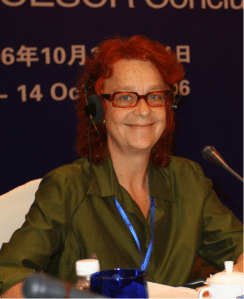 The final commentary in our symposium on Sophie Harman’s Seeing Politics, to be followed by a response from the author tomorrow. This intervention comes from Dean Cooper-Cunningham, who is a Ph.D. Fellow at the University of Copenhagen working at the intersections of visual politics, critical security studies, and feminist and queer theories. He is currently researching (responses to) Russian political queerphobia and is particularly interested in questions about the visuality of resistance and security. His recent work, published in the International Feminist Journal of Politics, focuses on seeing (in)security and theorises the interrelation of text/words, images, and the body through the case of the British Women’s Suffrage Movement. Previously, Dean held an editorial position with E-International Relations between 2015-2018 and was shortlisted for the Millennium: Journal of International Studies Northedge Prize in 2017.
The final commentary in our symposium on Sophie Harman’s Seeing Politics, to be followed by a response from the author tomorrow. This intervention comes from Dean Cooper-Cunningham, who is a Ph.D. Fellow at the University of Copenhagen working at the intersections of visual politics, critical security studies, and feminist and queer theories. He is currently researching (responses to) Russian political queerphobia and is particularly interested in questions about the visuality of resistance and security. His recent work, published in the International Feminist Journal of Politics, focuses on seeing (in)security and theorises the interrelation of text/words, images, and the body through the case of the British Women’s Suffrage Movement. Previously, Dean held an editorial position with E-International Relations between 2015-2018 and was shortlisted for the Millennium: Journal of International Studies Northedge Prize in 2017.
The full set of posts in this series is available here.
I want to echo Roland Bleiker’s blurb. This really is one of the best books I’ve read. It is provocative, innovative, feminist and decolonial to its core, and speaks to so many of the questions that I’ve found myself thinking about not just in relation to visual politics but to the way we ‘do’ and come to ‘know’ international politics. What is most inviting and enthralling about this project is that it seeks to challenge how we ‘see’ international relations (caps and lowercase) and global power structures by using narrative feature film. To that end, Seeing Politics builds on the important work of Michael Shapiro, Cynthia Weber, and William Callahan in bringing film to bear on the ‘stuff’ of international relations and the discipline itself. Academia has a habit of taking brilliant and inspiring projects and nonetheless finding flaws; I won’t do that here. Instead, I want to reflect on the ways that Seeing Politics provoked me, made me reflect on my own work and queer-feminist research practice, as well as the ways it speaks some of the big questions I’ve been grappling with about ‘voice’, ‘speech’, ‘language’, ‘subjectivity’, and what it means to ‘do’ politics and be ‘seen’. All of which are embedded in sexualised-racialised-gendered power structures that determine who is/can be heard and/or seen in IR.
As if pre-empting my notes in the margin about whether film—or for that matter any visual medium claimed to open access to spaces of public discourse and better allow for self-representation—can give voice to marginalised people and show the politics that we’ve been unaware of and/or ignoring, Harman links her work to debates on silence/ing (27-8). Drawing on feminist and decolonial critiques of speech, visibility, and who is/can be heard (Parpart 2010; Dingli 2015), Harman positions Seeing Politics and her co-produced film Pili as both methodological and epistemological interventions that enable African women—whose voices have often been co-opted and/or marginalised in IR scholarship—to be able to see and show themselves and their lived experiences of international politics. This is hugely ambitious, highly commendable, and quite provocative for a field, which, unlike other social sciences, has lagged behind in terms of the form we ‘do’ research in and (co)produce knowledge(s).
Above, I emphasise ‘give’ for one, perhaps pernickety, reason. Seeing Politics is built on decolonial and feminist foundations. These critical approaches endeavour to allow subjects, people, to self-represent and show “the everyday realities of lived experience from around the world and the ways in which people resist, assume, or adapt to” all of the political ‘stuff’ that structures their everyday lives (25). It is this foundation that makes me uneasy with the notion that film—when produced from within the structures of both the overwhelmingly white Western academy and filmmaking industry—gives (and/or amplifies) voice to the people whose experiences have been traditionally ignored, appropriated, and/or misrepresented. This isn’t a reservation I have of film as method and/or medium alone: Benjamin Dix’s PositiveNegatives project, which uses comics to share stories from the most marginalised in society, also provokes a similar response. Thinking these two aesthetic visual projects and ways of doing research together got me thinking about the argument Seeing Politics makes.
Is it really about giving and amplifying ‘voice’? Both yes and no, I think. The emphasis on feminist co-production and the bringing together over eighty women’s collective stories into Pili reads more like sharing the microphone/loudspeaker/pencil/keyboard/etc. Even more than that, this book and Pili push us even further to think about negotiating the Western emphasis on vocalisation as a means of entering politics, performing agency, and obtaining subjectivity (Spivak 1994; Dingli 2015). Seeing Politics in a sense dilutes the power Western philosophies attribute to voice and, in negotiating potential issues like white gaze and/or constructing African women’s lives and bodies through white feminist narratives, really establishes a space for turning to interactions of text/word, visuality, and body talk to see the performance of subjectivities and politics through other—equally powerful—mediums. Mediums that compliment, rather than outclass or replace one another. This is something various scholars have grappled with in theoretically driven ways (e.g., Hansen 2000; Parpart 2010; Cooper-Cunningham 2019).
Harman never claims to speak on behalf of or for the women who feature in both Pili and Seeing Politics. She meticulously shows us how each and every woman’s voice was included in the story of Pili. However, to say that film ‘gives voice’ risks both reifying a problem in Western scholarship that emphasises voice-as-agency (Dingli 2015) and downplaying the massive epistemological shift Seeing Politics encourages in Disciplinary IR. It risks suggesting that it is only through ‘us’ that people can speak; that the only ways unseen/ignored people can ‘speak’ and come into being as political subjects is through our (academic) work—be that film, comic books (as in PositiveNegatives), or articles/books. Is it the case that voice is being given? Or, is it rather, that “speech” in the form of a loud and present vocalisation is being reworked by film-making? Reconstituted in such a way that the forms of political participation and storytelling about the everyday experiences of, in this case, African Women emerge in new and innovative ways that disturb the epistemological privilege given to ‘voice’ and ‘speech’ using film? Not just in IR but social sciences more broadly?
For me, this is exactly what Seeing Politics does. Instead of questioning whether the subaltern can speak (Spivak 1994), Harman pushes social scientists to think about means of political engagement, resistance to (colonial, misogynistic, Eurocentric) discourses, and ways of doing politics and performing subjectivities that move beyond and deconstruct voice/silence, agency/passivity, political/apolitical dichotomies that structure (Western) academic thinking. And almost without explicitly saying that’s what it’s doing.
Seeing Politics is not just a decolonial work that allows for new types of knowledge (co-production) and ways of negotiating the hierarchies and tropes that plague Western academic scholarship and popular culture. Film-making allows for subjects to emerge and be seen in radically different ways than previously possible: through visualisation not vocalisation. This is clearest when Harman moves into her discussion of production: “it was clear that the more urgent and human stories were to be found in the rural areas of Miono and Mbewe, Those women were more isolated from the basic services…their stories were the ones that would go unseen” (71). In this sense, it is perhaps not that voice is (or needs to be) given to anyone but rather that other ways of doing and seeing (international) politics and research emerge. This is especially important in regard to the recurring defence Harman has to make: that film is not just a way of communicating existing research but a way of doing research, doing politics, seeing and showing the unseen.
This brings up an important reflection point. For whom do we study international relations? With all the talk of paywalls and gatekeeping in/of academic research, narrative feature-length film, which has its own barriers (Chapter 5), allows Harman to show that research isn’t just for our students and academic peers, for conferences/books/papers and the occasional blog or op-ed. To produce film is to not only make the politics we study visible to a wider audience and to consider the way that knowledge is aesthetically produced and consumed, but to think about the ways individuals (both as viewers and co-producers) are brought into research not as objects but as seeing/showing subjects and how our research discursively constitutes, has impact on, and is intertwined in the world (in) which we research.
By turning to visuality, Seeing Politics speaks to questions that I and many other scholars have tried to engage with: how is it that dominant narratives and political power structures are negotiated and/or resisted and/or reified; what does it mean to ‘do’ (international) politics; how does the visual exceed written/spoken discourse(s) and how can we work with and operationalise that particularity in the study and practice of international relations?
Speaking to visual analysis debates about “the death of the author” and Barthesian approaches to visual analysis that argue no visual has a singular meaning because they are interpreted differently by different audiences, Seeing Politics offers visual (IR) scholars a unique insight into both the intentions behind an inherently political film and a glimpse into the behind-the-scenes production of visuality. Not only does Harman take us through the importance and trials of film as IR method as she exposes all of the decisions, barriers, and possibilities of visualising research, she also give theoretical and methodological insight into the production aspect of photorealistic media.
This has an important takeaway even for scholars who do not wish to produce a visual project as research method—be it a film, comic, artwork, etc. Seeing Politics gives me inspiration for new types of question about the ways visuals get produced and what effects they have. Some things Seeing Politics (chapters 3-5 in particular) have forced me to confront in regard to my own research about visual resistance practices against Russian political queerphobia are: how individuals and activists gain entry and/or are prohibited from and/or constrained in entering international debates about queer rights; what the international political (visual) economy of queer/human rights looks like; and how ‘the digital’ and social media transform the political economy of visuality—who gets access, how, and who are the gatekeepers.
Seeing Politics raises so many more questions than it answers. That’s exactly the type of scholarship we need in the visual turn. On that, I will give the last word to a sentence that, for me, captured the decolonial and feminist essence and struggle of the project. It encourages self-reflexivity, inquisitiveness, and acknowledgement of positionality. I hope it provides you as much food for thought and reflection as it did me: “How one sees and who one sees are shaped by the political economy of where one is born and where one lives” (Harman 2019, 56).
Bibliography
Cooper-Cunningham, Dean. 2019. “Seeing (In)Security, Gender and Silencing: Posters in and about the British Women’s Suffrage Movement.” International Feminist Journal of Politics 21(3):383-408.
Dingli, Sophia. 2015. “We need to talk about silence: Re-examining silence in International Relations theory.” European Journal of International Relations 21(4):721-42.
Hansen, Lene. 2000. “The Little Mermaid’s Silent Security Dilemma and the Absence of Gender in the Copenhagen School.” Millennium Journal of International Studies 29(2):285-306.
Harman, Sophie. 2019. Seeing Politics: Film, Visual Method, and International Relations. Qeuebec:McGill-Queen’s University Press.
Parpart, Jane. 2010. “Choosing Silence: Rethinking Voice, Agency, and Women’s Empowerment.” In Secrecy and silence in the research process: Feminist reflections, edited by Róisín Ryan-Flood and Rosalind Gill, 15-29. London:Routledge.
Spivak, Gayatri. 1994. “Can the Subaltern Speak?” In Colonial Discourse and Postcolonial Theory: A Reader, edited by Laura Chrisman and Patrick Williams, 66-111. New York:Columbia University Press.

 The final commentary in
The final commentary in 
 ‘commitment to the men and women who live around you’, ‘recognizing the social contract that says you train up local young people before you take on cheap labour from overseas.’ And perhaps astonishingly, for a Conservative Prime Minister, May promised to deploy the full wherewithal of the state to revitalize that elusive social contract by protecting workers’ rights and cracking down on tax evasion to build ‘an economy that works for everyone’. Picture the Brexit debate as a 2X2 matrix with ideological positions mapped along an x-axis, and Remain/Leave options mapped along a y-axis to yield four possibilities: Right Leave (Brexit), Left Leave (Lexit), Right Remain (things are great) and Left Remain (things are grim, but the alternative is worse). Having been a quiet Right Remainer in the run-up to the referendum, May has now become the Brexit Prime Minister while posing, in parts of this speech, as a Lexiter (Lexiteer?).
‘commitment to the men and women who live around you’, ‘recognizing the social contract that says you train up local young people before you take on cheap labour from overseas.’ And perhaps astonishingly, for a Conservative Prime Minister, May promised to deploy the full wherewithal of the state to revitalize that elusive social contract by protecting workers’ rights and cracking down on tax evasion to build ‘an economy that works for everyone’. Picture the Brexit debate as a 2X2 matrix with ideological positions mapped along an x-axis, and Remain/Leave options mapped along a y-axis to yield four possibilities: Right Leave (Brexit), Left Leave (Lexit), Right Remain (things are great) and Left Remain (things are grim, but the alternative is worse). Having been a quiet Right Remainer in the run-up to the referendum, May has now become the Brexit Prime Minister while posing, in parts of this speech, as a Lexiter (Lexiteer?).